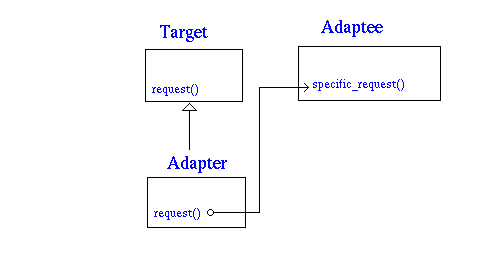BRIDGE and ADAPTER
Bridge
Implements a group of abstract classes in a hierarchy and the
corresponding implementations as independent classes
that can be combined dynamically. The abstraction and the implementation
can vary independently.
It allows to
- avoid a strong binding between abstraction and implementation;
- isolate changes in the implementation from the client;
- hide the implementtaion from clients;
- extend abstraction and implementation through subclassing;
The abstract and implementation hierarchies can be extended independently.
For example
- the Abstraction can be refined to expose additional methods of the
implementation (another_operation());
- the Implementor can provide different implementation of the method
(operation()) or additional methods (second_operation());
the new implementation is made available to clients seamlessly.
- if the Abstraction is refined to make use of the new methods, these
can also be made available to the clients;

class Implementor
{
public:
virtual void operation() = 0;
virtual void another_operation() = 0;
};
class Abstraction
{
public:
Abstraction( Implementor * imp ) : mImp( imp ) { }
virtual void operation() { mImp->operation(); }
protected:
Implementor * mImp;
};
class RefinedImplementor : public Implementor
{
public:
virtual void second_operation() = 0;
virtual void operation() { ... }
};
class RefinedAbstraction : public Abstraction
{
public:
RefinedAbstraction( RefinedImplementor * imp ) : Abstraction( imp ) { }
void second_operation() { mImp->second_operation(); }
void another_operation() { mImp->another_operation(); }
};
Adapter
The Adapter converts between the interface of a class (Adaptee) and the
interface (Target) that the client expects. The Adapter inherits from the
Target and can either inherit from the Adaptee (multiple inheritance,
as in the sample code below) or
delegate to the Adaptee (as in the figure).

class Target
{
public:
virtual void request() = 0;
};
class Adaptee
{
protected:
void specific_request();
};
class Adapter : public Target, public Adaptee
{
public:
void request() { specific_request(); }
};
See also
C# design patterns: Adapter,
by S.J. Metsker, 2004.

